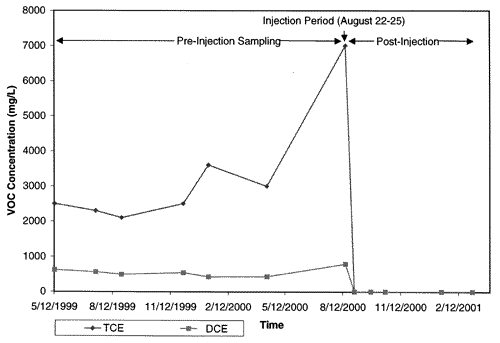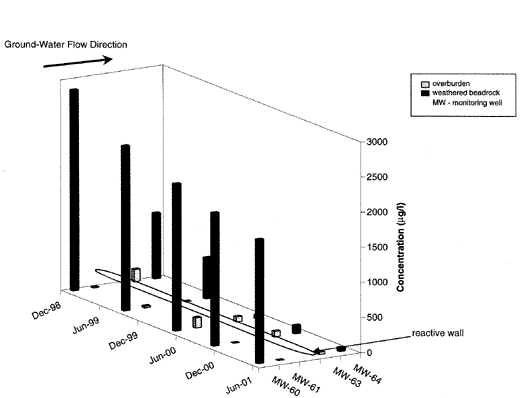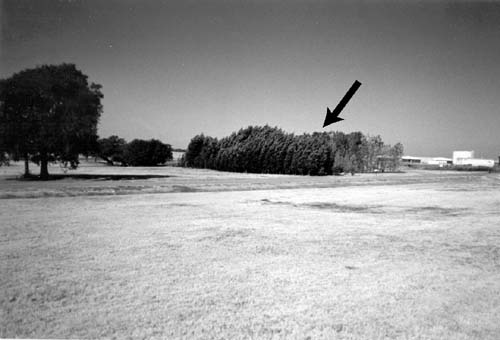|
Ground Water Currents, April 2002, Issue No. 43ContentsPermanganate Chemical Oxidation Used in Fractured Bedrock Performance of Dual Reactive Walls Monitored at Watervliet Arsenal Phytoremediation Field Demonstration Conducted at Naval Air Station Permanganate Chemical Oxidation Used in Fractured BedrockThe U.S. National Aeronautical and Space Administration (NASA) recently conducted a treatability study of in situ chemical oxidation (ISCO) using permanganate to destroy trichloroethene (TCE) in a fractured bedrock aquifer. The study took place at NASA�s Dryden Flight Research Center (Dryden) on Edwards Air Force Base (AFB), which is located north of Los Angeles, CA. Project researchers believe this study is the first to demonstrate the effectiveness of permanganate ISCO in fractured bedrock. Located on approximately 800 acres bordering Rogers Dry Lake, Dryden comprises laboratory, service, and storage buildings that support aeronautical research operations. The treatability study was conducted in a 100- by 50-foot area of "Site N7," at a treatment depth reaching 100 feet. This area contains approximately 5 feet of silty sand overlaying granitic bedrock. The first 10 feet of bedrock is moderately weathered, with fracture dips of 60-90 degrees and apertures of 0.08-0.77 inches. Ground water, which is at a depth of approximately 10 feet, is alkaline and slightly saline. Volatile organic compounds (VOCs) such as TCE and its natural degradation product, cis-1,2-dichloroethene (DCE), were detected at this area in maximum concentrations of 7,000 µg/L and 790 µg/L, respectively. Field operations involved the use of six existing screened wells and two newly constructed boreholes for injection. At each of the 8 locations, approximately 1,000 gallons of a 1.8-percent potassium permanganate (KMnO4) solution were injected into the bedrock. A 40:1 ratio of KMnO4 to VOC was selected to ensure complete delivery and oxidation of the solution. Injection rates ranged from 0.25 to 2 gallons per minute, at pressures ranging from 5 to 70 pounds per square inch (psi). In addition, air was introduced to the system at pressures up to 70 psi and flow rates up to 4 cubic feet per minute. Field injections were conducted for four days in August 2000. A total of 7,450 gallons of the KMnO4 solution, equivalent to 1,102 pounds of solid KMnO4, was injected. Offgas monitoring for carbon dioxide, oxygen, volatile organics, and lower explosive limit was discontinued after initial data indicated they were not produced in measurable quantities. Daily ground-water samples were analyzed to determine manganese, chloride, pH, and permanganate levels, but only permanganate concentrations were found to be useful indicators of the oxidation rate or reagent distribution. VOC and metals analyses occurred during packer testing, to evaluate the vertical distribution of VOCs; prior to injection, to establish baseline conditions; and in three post-injection rounds (at 5, 30, and 60 days) to evaluate performance of the technology. Monitoring locations were selected based on the known release location, pre-existing ground-water monitoring wells, and major fracture locations identified by a three-dimensional seismic survey. Destruction of TCE and DCE in the treatment zone was complete after 60 days, and concentrations remain below detection limits (Figure 1). Following injection, however, acetone at concentrations reaching 3,000 µg/L was detected, which suggested it formed as an oxidation product. Although acetone has attenuated to concentrations below 460 µg/L, researchers noted that it generally has not been reported as a permanganate oxidation product of chlorinated ethenes, and was not detected in pre-injection, bench-scale studies at Edwards AFB. Additionally, concentrations of most metals (possibily colloidal materials associated with the permanganate or liberated from the formation) were elevated during and following the period of injections.
With the exception of chromium, metal concentrations have fallen to pre-injection levels. Since the injection event, chromium concentrations have continued to decrease due to metal precipitation as the ground water returns to alkaline conditions. Permanganate concentrations in nearby wells and field observations of ground-water mounding near the injection wells were used to estimate the radius of influence (ROI) for the injection process. In some cases, the achieved ROI was better than the expected ROI of 30 feet. Data indicated a horizontal ROI of 30-55 feet and a vertical ROI of at least 28 feet. Implementation costs for permanganate ISCO at Site N7 are estimated at $72,000 (excluding project management, well installation, and reporting). No further treatment at Site N7 is anticipated as post-injection chlorinated solvent concentrations in targeted �hot spots� have remained below laboratory detection limits. Based on these study results, permanganate ISCO will be considered at other sites to remove chlorinated solvents dissolved in the fractured bedrock aquifer at Edwards AFB. For more information, contact Dan Morgan (NASA Dryden) at 661-276-3976 or dan.morgan@dfrc.nasa.gov, Dan Bryant (Geo-Cleanse International) at 908-206-1250 or dbryant@geocleanse.com, or Kimberly Coleman (Earth Tech) at 916-971-8705 or kimberly_coleman@earthtech.com. Performance of Dual Reactive Walls Monitored at Watervliet ArsenalIn 1998, the U.S. Army Corps of Engineers installed an in situ permeable reactive wall system at the Watervliet Arsenal (WVA) near Albany, NY, to remediate ground water contaminated with chlorinated hydrocarbons (CHCs). Monitoring data collected over the past three years indicates that CHC concentrations remain below detection levels and/or regulatory standards within and upon exiting the reactive walls. In addition, researchers estimate that a cost savings of over $3 million in operation and maintenance costs will be realized over the 30-year life cycle of the project, when compared to the conventional alternative of a pump and treat system. WVA contains a 14-acre unit known as the Siberia Area used since the early 1940s for the storage, handling, and shipping of raw materials and hazardous wastes or substances. One area of the site was used to burn combustible material such as scrap lumber, liquid wastes, and various solid wastes. The site contains three saturated, unconsolidated deposits overlying shale bedrock with an average porosity of 3-4 percent. These deposits comprise an upper 4-foot fill unit, a 2- to 6-foot unit of clayey silt extending to weathered bedrock, and a lower unit of fluvial sand and gravel. Ground water in this area is at a depth of approximately 3-6 feet below ground surface. During site investigations, a wide range of CHCs in high concentrations was found migrating along the shallow ground-water flow paths in the overburden and weathered bedrock. Contaminants of concern included trichloroethylene (1,500 µg/L), cis-1,2-dichloroethene (4,200 µg/L), tetrachloroethene (1,100 µg/L), and vinyl chloride (1,700 µg/L). The contaminant plume is estimated to be approximately 450 feet long and 200 feet wide. Bench-scale testing indicated that, at a flow velocity of 0.15 feet per day and a required residence time of 2.5 days for CHC degradation, optimal treatment would require a 0.82-foot-thick reactive wall consisting of 100 percent reactive iron filings. In addition, extensive ground-water modeling indicated that a continuous reactive wall, rather than a funnel and gate design, would prevent the escape of contaminated ground water under the wall. Design planning of the system found that conventional excavation or trenching with backfilling would result in excavation of 2.5-foot trenches, which were wider than the 0.82 feet required. To reduce the expense of placing extra reactive iron in the walls, iron filings were mixed with clean washed sand in a (1:1) ratio sufficient to maintain the required amount of iron. Ratios of the iron/sand mixture were controlled at an offsite cement mixing batch plant and sampled periodically throughout the construction process. The reactive system installed at WVA consists of a 200-foot-long reactive wall adjacent to the source area. A second 83-foot-long wall is positioned 175 feet downgradient of the first and approximately 300 feet from the source area. Each wall is set into the top of competent bedrock at a depth of 12 feet below ground surface. Inside each wall, wells at three locations are used to monitor chemical reactions and the production of precipitates. The complete system contains a total of 326,360 pounds of sand and 330,940 pounds of reactive iron. Construction costs for the reactive walls totaled approximately $280,000, which was estimated to be one-third of the cost for establishing a conventional pump and treat system for this site. Semi-annual hydraulic monitoring over the past three years shows that the ground-water flow is directed through both reactive walls without any short-circuiting, and that no head buildup exists on the upgradient side of the walls. Analytical monitoring shows that the zero-valent iron continues to reductively dehalogenate the CHCs through the natural corrosion process into non-toxic chloride ions and ethenes/ethanes. The most recent analytical results, which were obtained in May 2001, indicate that ground water exiting the walls contain concentrations below maximum contaminant levels for all targeted CHCs (Figure 2). WVA workers also have found that implementation of this technology has not disrupted ongoing activities at the Siberia Area, which involve primarily shipping of equipment and supplies for the manufacture of cannons.
Currently, WVA researchers are planning the installation of diffusion bag samplers in the reactive wall wells to improve CHC sampling and analysis. For more information, contact Stephen Wood (U.S. Army Corps of Engineers) at 410-962-3506 or stephen.c.wood@nab02.usace.army.mil, or Kenneth Goldstein (Malcolm Pirnie, Inc.) at 914-641-2615 or kgoldstein@pirnie.com. Phytoremediation Field Demonstration Conducted at Naval Air StationThe U.S. Air Force (USAF) initiated a field demonstration in 1996 involving the use of eastern cottonwood trees to remediate shallow ground water contaminated with trichloroethene (TCE) at the Naval Air Station (NAS) near Fort Worth, TX. Monitoring data indicate that TCE concentrations during the first three years after planting remained nearly constant due to a continuous influx of contaminated ground water. The mass flux of TCE out of the site, however, decreased by 11 percent due to transpiration of contaminated water directly from the aquifer. These conditions resulted in an overall decrease in contaminated ground water flowing from the site. By the end of the fifth growing season, in situ biodegration of the TCE had occurred locally beneath and immediately downgradient of the trees. The demonstration is taking place in a 1-acre area of the NAS, which was formerly known as Carswell Air Force Base. Earlier site investigations indicated a TCE plume in the shallow alluvial aquifer located 6-11 feet below ground surface. This extensive ground-water plume contains TCE concentrations within a range of low parts per billion. The sand and silt aquifer receives appoximately two inches per year in recharge from precipitation. Phytoremediation was selected at the NAS due to its low cost, minimal disruption, and general aesthetics. The tree plantings resemble a well-tended park, and blend seamlessly with the adjacent golf course (Figure 3). The technology is expected to serve as a natural pump and treat system involving any or all of three mechanisms:
Approximately 700 eastern cottonwood trees were planted at the NAS during the spring in rows 10 feet apart at a spacing of 4 and 8 feet. Irrigation of the trees was conducted during the first two years of growth. TCE concentrations in the ground water, rhizosphere soil, and tree tissues are monitored on a semi-annual basis, as are ground-water levels and tree sap flow. At full-system performance, the reduction in TCE mass flux due to transpiration directly from the aquifer has been modeled at 20-30 percent. The reduction in the TCE mass flux due to in situ biodegration has yet to be determined. Current results of the demonstration, which was funded jointly by the U.S. EPA Office of Research and Development under its Superfund Innovative Technology (SITE) Program and the U.S. Department of Defense under its Environmental Security Technology Certification Program (ESTCP), will be published later this year. The USAF anticipates full-scale implementation of phytoremediation at the NAS through the planting of additional trees during 2003. For more information, contact Steven Rock (National Risk Management Research Laboratory) at 513-569-7149 or rock.steven@epa.gov, or Greg Harvey (USAF) at 937-255-7716 x302 or gregory.harvey@wpafb.af.mil.
|











